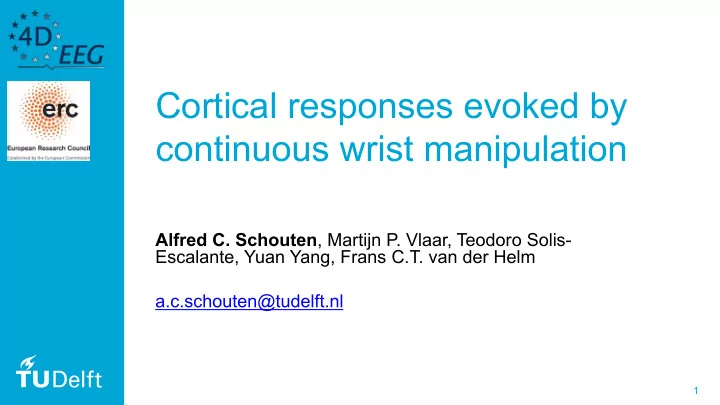

Cortical responses evoked by continuous wrist manipulation Alfred C. Schouten , Martijn P. Vlaar, Teodoro Solis- Escalante, Yuan Yang, Frans C.T. van der Helm a.c.schouten@tudelft.nl 1
Benchmark data based on two articles 2
Brain as controller of the human body cortex 2. cortical loop spinal cord reflex modulation 1. spinal reflex loop muscle & sketeton mechanical proprio- interaction ceptors 3 Scott, 2004
Motivation • Stroke – Disturbed blood supply to the brain – Hemiparesis • Rehabilitation therapy – Restitution or compensation? • Restitution => focus on affected side • Compensation => focus on non-affected side • Initial sensory function might predict potential recovery – Select best therapy for the individual patient 4
Recording brain activity • EEG: electroencephalography • Electrodes measure electrical potential at scalp – Noisy data – Volume conduction – Requires many parallel oriented neurons to fire synchronously • Preparation (0.5 - 1 hour) – Apply cap and conductive gel • Data analysis – Manually remove all trials which contain artefacts • Eye blinks, movements, etc. – Analysis at: • electrode level or • source level (ICA: Independent Component Analysis) 5
Experiment • 126 channel EEG • 10 subjects, 2 tasks – Passive task (‘do nothing’), angular perturbations – Active task (‘keep position’), torque perturbations 6
Experiment • Perturbations: – random phase multisines with 10 frequencies – 1 s period with 1,3,5,6,9,11,13,15,19,23 Hz • M=7 realizations, – each P=210 periods • 7*210=1470 periods of 1s – 25 min of data per task, excl. breaks – 2 hours of recording 7
Recording and analysis • Recorded signals (@2048Hz) – Torque, angle, EMG (flexor&extensor), EEG (126 ch.) • Analysis – SNR for each electrode – ‘best’ electrode: power in excited frequencies, even & odd harmonics 8
Method: detecting nonlinearities LTI NLTI Pintelon & Schoukens, 2012 9
Cortical response 10
Nonlinearities 11
cortex Intermediate summary 2. cortical loop spinal cord reflex modulation • Mechanics 1. spinal reflex loop – 99% in excited frequencies muscle & sketeton • ~linear, muscle visco-elasticity mechanical proprio- interaction ceptors • EMG – ± 25% power in harmonics • EEG – ± 80% power in harmonics • => highly nonlinear! 12
Analysis and modelling • Source localization: ICA analysis • Analyse ‘best’ ICA – 4 groups of frequencies • f1: excited frequencies • f2: 2 nd harmonics • f3: 3 rd harmonics (excl. f1) • f4: 4 th harmonics (excl. f2) 13
Modelling • h 1 : Best Linear Approximation (BLA) • h 2 : regularized Volterra kernels (2 nd order) Pintelon & Schoukens, 2012 14 Birpoutsoukis et al. Automatica, 2017.
Results 2 nd order Volterra • Power distribution 15
Main findings • Quantifying nonlinear contributions (paper 1) – Highest SNR found over contralateral cortex – SNR of electrodes with highest SNR: -14.8 dB – Cortical response is highly nonlinear (>80%) • Modelling the nonlinear cortical response (paper 2) – SNR of best source (ICA component): -12.3dB – Estimated noise level 8% – Truncated Volterra model explains 46% – High similarity of the obtained models across participants – Models show high-pass behavior, suggesting velocity- sensitivity (muscle spindle) 16
Main challenges 1. What is the nonlinearity? – Efficient models without prior assumptions – Intuitive description of the identified nonlinear model – => insight into the physiological origin 2. One common model structure to fit all subjects/data – Compare parameters between groups (healthy vs. disease) – Track stroke subjects over time (neuroplasticity) – => diagnostic/monitoring tool 3. Network connectivity – Track the sensory signal through the brain – Connectivity between sources/components – => altered brain networks after e.g. stroke 17
Available datasets • Small (<1Mb): input (handle angle) - output (best ICA) averaged over periods for every participant and multisine realization, resampled at 256Hz (www.nonlinearbenchmark.org) • Medium (around 500Mb): as small, but not averaged over periods and at the original sample rate of 2048Hz (www.nonlinearbenchmark.org) • Large (around 60Gb): Only filtered and segmented in 1 s periods. Includes all 126 EEG channels at 2048Hz, and the ICA matrix to convert channels to sources. Available at 4TU Centre for Research Data (data.4tu.nl) 18
4D-EEG project team VU University Medical Center Amsterdam Delft University of Technology Gert Kwakkel (Co-PI) Frans C.T. van der Helm (PI) Erwin E.H. van Wegen Alfred C. Schouten Jan C. de Munck Yuan Yang Carel Meskers Martijn P. Vlaar Caroline Winters Teodoro Solis-Escalante Aukje Andringa Mark van de Ruit Sarah Zandvliet Konstantina Kalogianni Mique Saes Lena Filatova Lucas Haring Dirk Hoevenaars Northwestern University Feinberg School of Medicine Chicago VU University Amsterdam Julius P.A. Dewald Andreas Daffertshofer Jun Yao 19
Recommend
More recommend